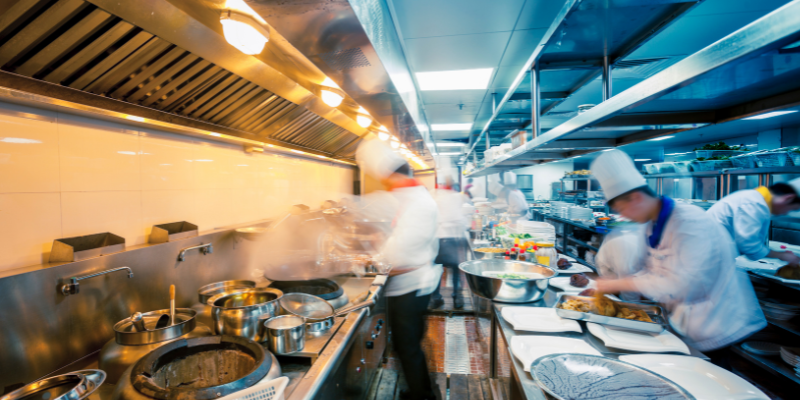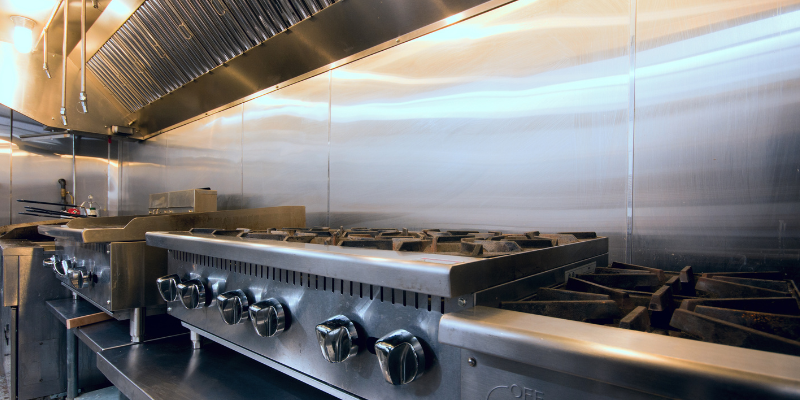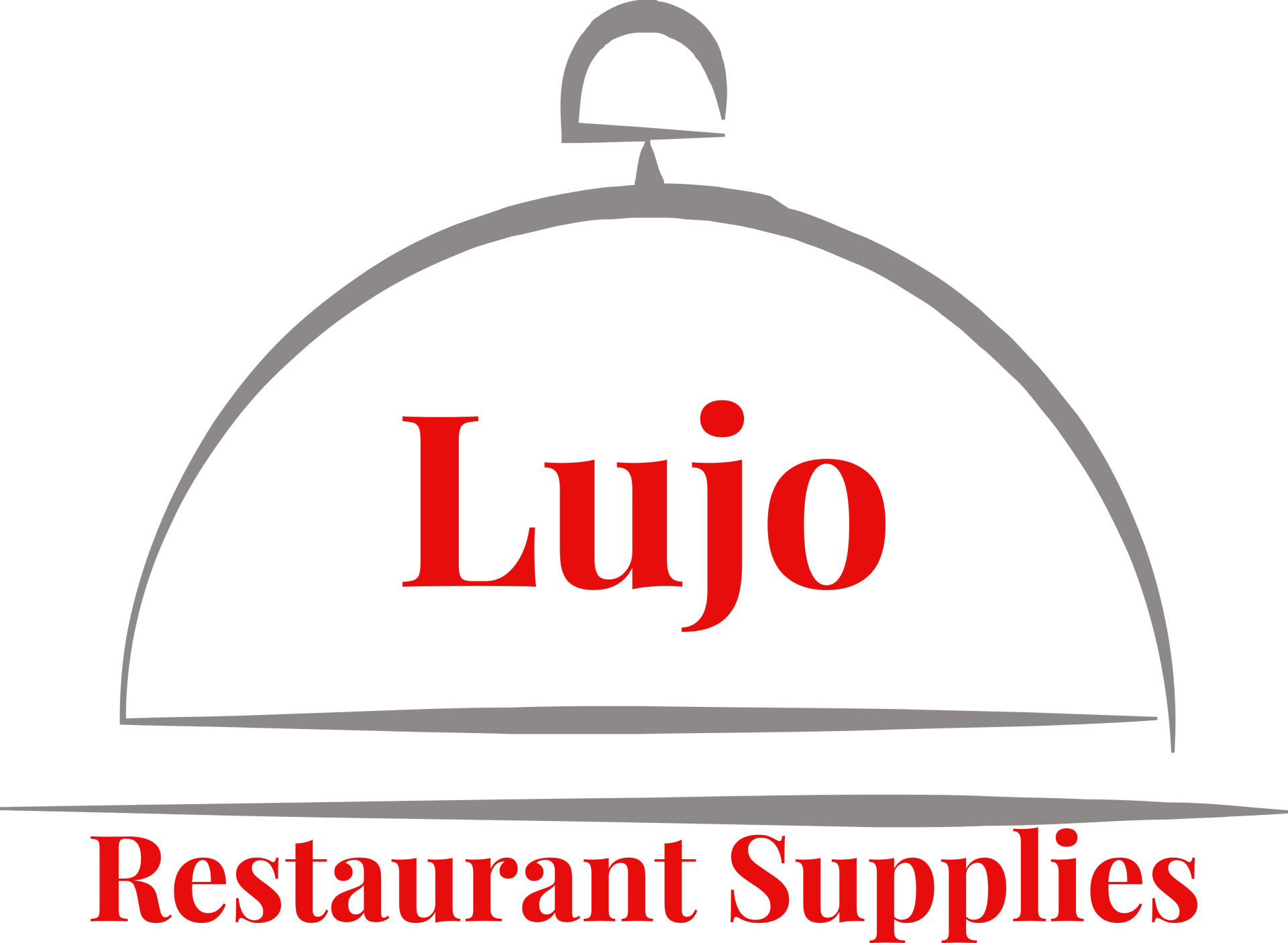Table of Contents
ToggleWith the constant juggle between keeping costs low and quality high, the importance of a reliable commercial kitchen supply cannot be overstressed.
In today’s fast-paced culinary world, maintaining an efficient and cost-effective commercial kitchen is paramount for restaurant owners.
The right supplies can make or break your restaurant’s reputation and profitability.
But how do you navigate the complex landscape of commercial kitchen supplies to ensure your kitchen runs like a well-oiled machine?
Let’s dive into the intricacies of commercial kitchen supply management and uncover strategies to cut costs and increase efficiency in your restaurant.
Key takeaways:
- The basics of commercial kitchen supplies
- Finding good suppliers
- Reducing high costs of supplies
- Overcoming slow shipping
- Streamlining your restaurant operation

Understanding the Basics of Commercial Kitchen Supply
Navigating the essentials of commercial kitchen supply is akin to laying the foundation for a culinary empire.
This critical step goes beyond merely stocking up on equipment and utensils.
It involves a deep dive into identifying the tools and resources that truly align with your kitchen’s operational goals and culinary aspirations.
Commercial kitchen supply encompasses a wide array of items, from high-performance cooking equipment and refrigeration units designed to withstand the rigors of a bustling kitchen, to the more humble yet equally important glassware, cutlery, dishes, and cleaning materials that ensure a smooth and hygienic operation.
The key to mastering this aspect lies in discerning between what is crucial for your kitchen’s functionality versus what is superfluous.
Every item in your kitchen must improve efficiency
Every item within your kitchen should earn its place by contributing to efficiency, improving workflow, and enhancing the overall quality of the food you serve.
This evaluation requires thoughtful consideration of your menu, cooking techniques, and the volume of business you anticipate.
For instance, a high-capacity commercial oven might be indispensable for a bakery or a pizzeria but less so for a small café specializing in cold dishes.
It’s also vital to consider the durability and reliability of the supplies and the commercial dinnerware you choose.
Investing in high-quality, durable equipment may have a higher upfront cost but pays off in the long run through reduced maintenance issues and longer service life.
Similarly, opting for supplies that are easy to clean and maintain can save significant time and labor, further optimizing your kitchen’s efficiency.
In summary, understanding the basics of commercial kitchen supply is about more than just acquiring equipment and items.
It’s about making informed decisions that align with your operational needs, culinary vision, and business goals, ensuring every piece contributes to a harmonious, efficient, and productive kitchen environment.
Navigating the Challenges of Finding Reliable Suppliers
Finding reliable commercial kitchen supply dealers is a hurdle many restaurant owners face.
The vast market offers myriad options, yet sifting through them to find quality, reliability, and timely delivery can feel like searching for a needle in a haystack.
The cornerstone of a fruitful partnership with restaurant kitchen suppliers lies in diligent research and communication.
Prioritize vendors known for their steadfast service and high-quality products.
Engaging in conversations with potential suppliers, and asking pointed questions about their product sourcing, delivery timelines, and support services can reveal much about their suitability for your needs.
Building a network of restaurant supply dealers rather than relying on a single source is another strategic approach.
This not only cushions your operations against unexpected supply disruptions but also puts you in a position to compare pricing and quality, ensuring you get the best value for your investment. It’s crucial to stay proactive, keeping abreast of market trends and new entrants who might offer innovative solutions or more competitive pricing.
Moreover, leveraging your professional network can unearth valuable insights.
Other restaurant owners or culinary professionals might provide recommendations based on their own experiences, highlighting suppliers who have been particularly reliable or offered exceptional customer service.
Sign up for online forums and trade associations
Online forums and trade associations can also be rich resources for peer-reviewed suppliers.
A key aspect often overlooked is the alignment of supplier practices with your restaurant’s values, such as sustainability efforts or local sourcing commitments.
Restaurant equipment suppliers who share your values not only bolster your restaurant’s ethos but often foster stronger, more collaborative relationships.
In essence, navigating the challenges of finding reliable suppliers demands a mix of thorough research, strategic networking, and a keen eye for aligning suppliers’ practices with your restaurant’s values.
These steps pave the way towards establishing robust, beneficial relationships with suppliers that can withstand time and operational pressures.

Strategies for Reducing High Costs of Restaurant Supplies
Navigating the financial pressures associated with commercial kitchen supply requires a savvy approach to procurement and resource management.
A key strategy for mitigating these costs lies in the art of negotiation and relationship-building with suppliers.
Establishing strong connections can open the door to exclusive deals, discounts, and favorable terms, which are often not advertised to the general market.
By demonstrating loyalty and a steady volume of business, you may gain access to pricing structures that significantly lower your overheads.
Adopting a proactive approach to equipment maintenance is another essential strategy.
Regular servicing and proper care can vastly extend the lifespan of your kitchen tools and appliances, thereby deferring the need for costly replacements.
This practice not only saves money in the long run but also ensures that your kitchen operations run uninterrupted, avoiding the hidden costs associated with downtime and emergency repairs.
Explore the pre-owned restaurant equipment option
Exploring the secondary market for kitchen supplies offers yet another avenue for cost savings. High-quality, pre-owned equipment can often be procured at a fraction of the cost of new items.
Many pieces of commercial kitchen equipment are built to last and can serve your needs well, even if they’ve had a previous owner.
However, it’s crucial to exercise due diligence, ensuring that any used equipment is in good condition and meets your specific requirements.
Lastly, embracing the concept of a lean inventory can play a significant role in reducing costs.
By closely monitoring inventory levels and adopting just-in-time ordering practices, you can minimize the capital tied up in unused stock and reduce the risk of spoilage or obsolescence.
This lean approach to supply management not only conserves financial resources but also promotes a more agile and responsive kitchen operation.
Overcoming Slow Shipping Times to Keep Your Kitchen Running
In the high-stakes environment of a commercial kitchen supply, where every second counts, slow shipping times for essential supplies can throw a wrench in the smooth operation of your establishment.
Proactively addressing this challenge is crucial to maintaining a seamless workflow and ensuring that your culinary operations are never hampered by the unavailability of necessary items.
One effective strategy is to develop a predictive inventory system.
By analyzing historical usage data, you can forecast future needs and time your orders to account for potential shipping delays, ensuring that you are never caught off guard.
This system allows for the early identification of supplies that are running low, giving you ample time to source alternatives if your primary supplier cannot meet your timeframe.
Diversify your supply chain
Building relationships with multiple suppliers also provides a safety net against slow shipping times.
By diversifying your supply chain, you gain the flexibility to source products from alternative vendors should your primary supplier be unable to fulfill an order promptly.
This approach not only reduces dependency on a single source but also encourages competitive pricing and service levels among suppliers.
In addition, consider partnering with local suppliers whenever possible.
Local sourcing can significantly reduce shipping times, support the local economy, and often ensure fresher supplies for your kitchen.
Establishing a network of local producers and suppliers can provide a quick turnaround for many items, minimizing the impact of delays from distant suppliers.
Finally, embracing a just-in-case inventory model for your most critical supplies can be a game-changer.
Keeping a calculated buffer stock of essential items ensures your kitchen operations can continue smoothly, even when faced with unexpected shipping delays.
While this requires careful management to avoid overstocking, it’s a strategic approach that can save significant time and stress in the long run.
By implementing these strategies, you can effectively mitigate the impact of slow shipping times, maintaining operational continuity and ensuring that your kitchen always runs at peak efficiency.

Embracing Technology for Streamlined Kitchen Operations
In the realm of commercial kitchens, where efficiency and precision are paramount, the role of technology cannot be overstated.
Advanced digital tools are revolutionizing how restaurants manage their kitchen supplies, leading to significant time and cost savings.
By integrating inventory management software, you can automate the process of tracking your commercial kitchen supply in real-time, reducing the risk of stockouts and overordering.
This technology enables you to have a clear view of their inventory levels, usage patterns, and reorder needs at a glance, ensuring that the kitchen remains well-stocked without tying up unnecessary capital in surplus supplies.
Digital ordering systems further refine the procurement process, allowing for seamless communication with suppliers and streamlined order placements.
Harness modern technology to streamline your ordering system
These systems often come with the added advantage of tracking order statuses and delivery times, providing kitchens with the ability to plan more accurately and react swiftly to any supply chain disruptions.
Additionally, the use of predictive analytics in these platforms can forecast future supply needs based on historical data, seasonal trends, and upcoming events, optimizing order quantities and timing.
Moreover, kitchen operation technologies extend beyond inventory and procurement.
Digital kitchen display systems (KDS) replace traditional paper tickets, enhancing order accuracy and kitchen efficiency by displaying real-time orders to the kitchen staff, prioritizing tasks, and tracking cooking times.
This integration of technology not only speeds up service but also reduces waste and errors, contributing to a smoother operation and a better dining experience for customers.
By embracing these technological solutions, you can significantly enhance your commercial kitchen’s operational efficiency.
The move towards digitalization not only automates mundane tasks but also provides valuable insights for making informed decisions, ultimately fostering a more agile, responsive, and profitable kitchen environment.
Sustainable Practices in Commercial Kitchen Supply Management
Incorporating sustainability into the management of commercial kitchen supply is becoming an indispensable strategy for modern restaurants aiming to align with environmental stewardship while potentially reducing operational costs.
One effective method is selecting suppliers who are committed to sustainable practices.
This can range from those utilizing renewable energy sources in their production processes to those offering products made from recycled or biodegradable materials.
Such choices not only minimize the ecological footprint of your kitchen but also resonate with a growing segment of consumers who prioritize environmental responsibility.
Another avenue for fostering sustainability is through the optimization of supply chain logistics. By partnering with local producers and suppliers, you can significantly reduce carbon emissions associated with long-distance transportation.
This practice not only supports local economies but also ensures fresher ingredients for your kitchen, enhancing the quality of your culinary creations.
Efficient resource management also plays a critical role in sustainable kitchen operations. Implementing measures to reduce water and energy consumption, such as investing in energy-efficient appliances and adopting water-saving techniques, can lead to substantial savings on utility bills.
Additionally, embracing a zero-waste philosophy by finding creative ways to repurpose food scraps and other materials not only reduces landfill contributions but can also inspire innovation in menu development.
Lastly, educating your team on the importance of sustainable practices is crucial.
A well-informed staff becomes more conscientious in their daily activities, from minimizing food waste to efficiently managing inventory, contributing to the overall sustainability goals of your restaurant.
Through these concerted efforts, adopting sustainable practices in commercial kitchen supply management not only paves the way for a greener planet but also builds a more resilient and cost-effective business model.
Final Thoughts on Maximizing Your Commercial Kitchen Supply Efficiency
Optimizing your commercial kitchen supply chain is an intricate endeavor that demands a strategic, comprehensive approach.
It’s about striking the perfect balance between cost-effectiveness and operational excellence, ensuring that every facet of your kitchen supply management works in harmony towards the overarching goal of heightened efficiency and reduced overheads.
This involves a continuous cycle of evaluation and adaptation, where informed decision-making and proactive measures pave the way for a more streamlined, resilient operation.
A key aspect of this journey is the emphasis on building robust relationships with suppliers, embracing a culture of preventive maintenance, and being agile in your inventory management practices.
The integration of cutting-edge technology stands as a cornerstone in this process, offering unparalleled insights and automation capabilities that free up valuable time and resources.
Additionally, embedding sustainability into the core of your supply chain not only addresses the pressing environmental concerns of our time but also unveils opportunities for cost savings and enhanced brand reputation.
In navigating these multifarious challenges and opportunities, the focus must always remain on delivering exceptional culinary experiences without compromising on quality or sustainability.
Commit to continuous improvement and innovation
This requires a keen eye for innovation, a commitment to continuous improvement, and a deep understanding of the unique dynamics of your kitchen operations.
By adhering to these principles and adapting them to your specific context, you can elevate your kitchen’s efficiency to new heights, fostering a thriving, profitable restaurant business that stands the test of time.

